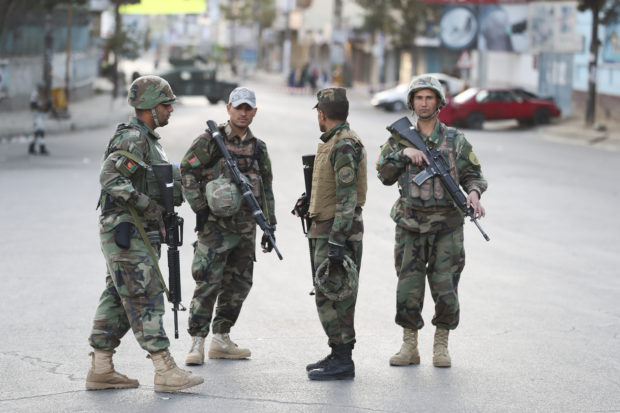UN: 14,000 ‘grave violations’ against Afghan kids in 4 years

Afghan soldiers stand guard near a polling station in Kabul, Afghanistan, Saturday, Sept. 28, 2019. (AP Photo/Ebrahim Nooroozi)
UNITED NATIONS — Deteriorating security across Afghanistan in the past four years led to over 14,000 “grave violations” against children, including nearly 3,500 youngsters killed and over 9,000 injured, according to a U.N. report circulated Thursday.
Secretary-General Antonio Guterres condemned “the alarming level” of grave violations committed by all parties and the fact that children “continue to bear the brunt of the armed conflict.”
Of serious concern, he said, is that the nearly 12,600 children verified to have been killed or injured in 2015-2018 represented almost a third of all civilian casualties. That was “an increase of 82 percent in child casualties compared with the previous four years,” he wrote.
Guterres said in his fourth report on children and armed conflict in Afghanistan that the rise was traced to “an increase in child casualties resulting from ground engagements, explosive remnants of war and aerial attacks.”
The U.N. chief said he is “extremely concerned,” especially by the number of children killed and injured as a result of “aerial operations conducted by government and pro-government forces.”
Article continues after this advertisementAccording to the report, child casualties from airstrikes “have significantly increased since 2015,” reversing the downward trend of the four preceding years. The U.N. verified 1,049 child casualties from airstrikes in 2015-2018, including 464 youngsters killed. That represented 40% of civilian casualties from aerial attacks, the report said.
Article continues after this advertisementGuterres said armed groups were responsible for 43% of child casualties: 3,450 killed and 9,149 injured. While Taliban fighters were responsible for the majority, the number attributed to the Islamic State extremist group increased overall during the four-year period, he said.
Government and pro-government forces were responsible for 30% of child casualties, he said.
Guterres said U.N. also verified the recruitment and use of 274 children by armed groups and government forces, sexual violence against 13 boys and four girls, and 467 attacks on schools and education personnel.
The secretary-general said the actual number of children recruited and used in the Afghan conflict “is estimated to be much higher,” citing as an example allegations in 2016 that over 3,000 children were recruited, mainly by armed groups.
Similarly, Guterres said rape and other forms of sexual violence against children “is known to be underreported as a result of prevailing social norms, fear of retaliation and impunity.”
In a study by the U.N. political mission in Afghanistan between October 2016 and December 2017, he said, people in communities across Afghanistan “shared their perceptions that the use of boys for the purposes of sexual abuse and exploitation, including bacha bazi, by parties to conflict was common and widespread.” Bacha bazi is a practice in which wealthy or powerful men exploit boys for entertainment, especially dancing and sexual activities.
Guterres cited the case of a boy in Takhar province who was held for about a year by several armed commanders, including national police commanders, “and used for bacha bazi.”
In an overview of political and security developments in 2015-2018, the secretary-general said the situation deteriorated compared to the previous four years, “notably following the transfer of responsibility for security from international forces to the Afghan National Defense and Security Forces in 2014.” The following year, he said, the Taliban made “significant territorial inroads.”
Guterres said in recent months, 45,000 to 65,000 Taliban fighters were reportedly active in Afghanistan “although estimates vary considerably.” He added that “the Haqqani network has assumed an increasingly influential role in the Taliban’s military operations.”
The secretary-general said al-Qaida “is believed to maintain a limited presence in eastern Afghanistan” while the Islamic State extremist group is also present in eastern Afghanistan, “with 2,500 to 4,000 elements believed to be currently active.”
Operations by Afghan and international forces have constrained the Islamic State group’s expansion, Guterres said, and as a result IS has “increasingly relied on suicide and complex attacks deliberately targeting civilians in large cities.” /kga